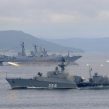
Russia’s Navy Muscles Up and Looks East
Publication: Eurasia Daily Monitor Volume: 8 Issue: 23
By:

According to Russia’s decade-long military procurement plan the Navy will receive 4.7 trillion rubles ($159 billion) of the total 20 trillion rubles ($678 billion), a figure that Prime Minister, Vladimir Putin considers as being scary (Vedomosti, December 14, 2010). Of course, this builds upon existing programs that saw the completion in 2010 of construction to adapt the new Borey class submarines to the new Sineva-2 missile and the launch of the first Yasen class submarine –the multipurpose Severodvinsk. The first Lada class submarine was also commissioned in 2010. Russia is also working on a new generation destroyer to correspond to today’s cruisers and possess an anti-submarine warfare capability (ASW). A new Admiral Gorshkov frigate, corvettes, and small missile ships are being constructed. Only in 2013-14 is Moscow planning to begin building a new aircraft carrier that will be commissioned in 2020 (Argumenty Nedeli Online, December 15, 2010).
Although some analysts have argued that the Russian Navy is becoming a power projection fleet, this construction program indicates a fleet whose main operational mission is defense of the maritime approaches to Russia, not power projection. Indeed, an authoritative article in Krasnaya Zvezda stated that the Navy’s priority is maintaining the composition and combat readiness of the naval nuclear forces and constructing multipurpose submarines and surface ships for near and far sea sources. But in the absence of an aircraft carrier, power projection becomes an almost unsupportable mission in wartime (Krasnaya Zvezda, December 29, 2010).
However, beyond construction plans the actual and forthcoming deployment of naval assets reveals Moscow’s threat perceptions and defense policy. A total of 36 submarines and 40 surface ships are to be added by 2020 (Trud, November 28, 2010, Nezavisimoye Voyennoye Obozreniye, December 10, 2010). Furthermore, these plans betray a reorientation of Russia’s naval priorities to the Asia-Pacific Region, and a new emphasis on meeting the challenge posed by China’s naval buildup. Indeed, this naval buildup is supposed to help Russia compensate for its vast conventional inferiority in numbers and quality vis-à-vis China in the Russian Far East (Trud, November 28, 2010; Nezavisimoye Voyennoye Obozreniye, December 10, 2010).
In the Pacific Ocean, according to Japanese sources, Moscow is deploying formerly retired ships such as the nuclear powered Admiral Lazarev, a decommissioned Kirov class nuclear missile cruiser, to counter the rise in Chinese power and deter threats ranging from an outbreak of war in Korea to growing Chinese naval and strike power in addition to a US buildup. One high-ranking Russian naval officer openly said that, “in order to maintain a power balance with China in the far eastern ocean area, it has become urgent that we reinstate nuclear ships that enable long-range area navigation and are equipped with advanced attack capabilities” (Tokyo Shimbun Morning Edition, May 10, 2010). Arguably, Moscow is contemplating turning its Pacific Fleet into its main fleet, to ensure the security of its energy deposits and the integrity of the Russian Far East, as this area becomes more central to Russia’s strategic future. Indeed, the first of the newly purchased Mistral class ships is reportedly to be deployed in the Pacific ostensibly to defend the Kurile Islands against Japan (Rossiyskaya Gazeta Online, December 28, 2010). Yet, it will also be able to defend against China, a much more aggressive Asian power.
This is not the only noteworthy deployment. The Caspian Flotilla has been reinforced and deployed along the coast of Dagestan. Again, ostensibly to combat terrorist operations that is undoubtedly rife throughout the North Caucasus. But this flotilla also has a potent arsenal of anti-ship missiles and other assets that will allow it to prevent any Iranian moves in the Caspian. Inasmuch as these deployments to the Caspian were announced after the failure of the most recent effort to delimit the Caspian Sea among its littoral powers, there is an unmistakable subtext to these initiatives (Nezavisimaya Gazeta Online, December 16, 2010; Nastoyashchaya Vremya [Makhachkala], December 24, 2010).
There are, however, several problems stemming from the fact that despite such massive expenditures Russia still lacks an infrastructure capable of supporting the construction of so many ships by 2020 to a modern standard. Furthermore, it lacks the infrastructure in the Pacific to sustain the fleet there. That is an abiding strategic problem. Throwing money at these problems is not a solution. The design for the new diesel submarine is flawed and this obliges the navy to return to the old design (Interfax, December 27, 2010).
Similarly, the problems at the Baltiysk shipyard are so severe that they may lead it to cease activity as a shipbuilding enterprise (www.dp.ru [St. Petersburg], November 18, 2010). Equally, naval commanders including Admiral Vladimir Korolev, Commander of the Black Sea Fleet, indicated that the current reform of the armed forces will restore to the military a number of positive elements that existed in Soviet times (Rosbalt, December 21, 2010). So once again we encounter the ever-present conundrum of Russian strategic plans and policy, ambitious plans, that apparently cannot be sustained based on the available resources. But if the 4.7 trillion rubles ($159 billion) is wasted or falls short, which is likely in the absence of major reform, from where will the money come in the future to reconstruct not just the Russian navy but also its accompanying infrastructure?




